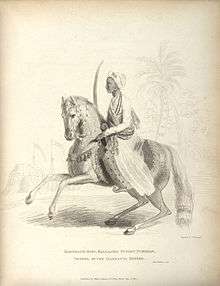Raghunathrao
| Shreemant Raghunath rao Ballal Peshwa Shreemant Peshwa | |
|---|---|
 | |
|
In office 5 December 1773 – 1774 | |
| Monarch | Rajaram II |
| Preceded by | Narayanrao |
| Succeeded by | Madhavarao Narayan |
| Personal details | |
| Born |
18 August 1734 Satara |
| Died | 11 December 1783 (aged 49) |
| Nationality | Indian |
| Profession | Peshwa |
| Religion | Hinduism |
Shreemant Raghunathrao Ballal Peshwa (aka Ragho Ballal or Ragho Bharari[1]) (b. 18 Aug.1734 – d. 11 Dec.1783) was Peshwa of the Maratha Empire from 1773 to 1774.
Early life
Raghunathrao, also known as "Raghoba", "Raghoba Dada" and "Ragho Bharari," was the younger brother of Nanasaheb Peshwa. His father was Peshwa Bajirao I & mother was Kashibai. Raghunathrao was born in Mahuli near Satara on 8 December 1734. Much of his childhood was spent in Satara.
In his early years he fought with great success in the north. His expedition during 1753–1755 was concluded by an advantageous treaty with Jat. He is favorably remembered by Hindus for the fact that during that expedition he brought an end to Muslim rule at Hindu religious places such as Mathura, Vrindavan, Gaya, Kurukshetra. Raghunathrao imprisoned Mughal Emperor Ahmad Shah Bahadur and made Alamgir II Emperor in his place.
Ahmad Shah Durrani (of present-day Afghanistan) approached Punjab in 1760 and defeated Dattaji Scindia in battle of Barari Ghat near modern-day Delhi, Dattaji was also killed in battle.To counter this Raghunathrao was supposed to go north to handle the situation. Raghunathrao asked for large amount and an army, which was denied by Sadashivrao Bhau, his cousin and Diwan of Peshwa, so he declined to go. Sadashivrao Bhau was there upon made commander in chief of the Maratha Army,under whom the Battle of Panipat was fought.
After the crushing Maratha defeat at Third Battle of Panipat, his brother Nanasaheb Peshwa's death and his half brother's (Shamsher Bahadur I) death in 1761, Raghunathrao had plans to seize the Peshwa throne for himself, but instead the throne was passed on to his nephew Madhavrao I, son of Nanasaheb.
Regency
He was appointed as a regent to the young Peshwa, but tried to interfere with the administration. He soon fell out of favour with the Peshwa, and even tried to conspire against him by joining the Nizam of Hyderabad against the Peshwa. The alliance was defeated at Ghodegaon, and Raghunathrao was placed under house arrest. After Madhavrao I's death in 1772, Raghunathrao was released from house arrest. He then became the regent of Madhavrao's younger brother Narayanrao. Together with his wife Anandibai, he had his nephew Narayanrao murdered. Anandibai herself was very cruel and cunning in her ways.
Legend has it that when the assassins attacked the young Peshwa, he ran to Raghoba crying "Kaakaa malaa waachwaa" (Uncle, save me). His cry fell on deaf ears and Raghoba stood by as his nephew was killed. After Narayanrao's murder, Raghoba became Peshwa, but he was shortly overthrown by Nana Phadnis and 11 other administrators in what is called "The Baarbhaai Conspiracy" (Conspiracy by the Twelve). Raghunathrao was tried, convicted, and sentenced to death by the justice Ram Shastri Prabhune but the sentence was never carried out.
At Kasegaon near Pandharpur the first battle between the Baarbhai and Raghobadada took place in 1774. He then went to Khambhat with hope of getting help from the British, who did not help but transported him to Surat from their ship.
At Surat a treaty was signed between Raghunathrao and the British East India Company on 6 March 1775. According to the treaty it was decided that Thane, Vasai and Sashti were to be handed over to the British, and in return the Company would assist Raghunathrao to become the Peshwa.[2]
However, the Company was not yet ready for war, so that the treaty between the Baarbhai and the Company was signed at Purandar. After the Treaty of Purandar (1776), the Company openly distanced itself from Raghunathrao and asked him to live as their pensioner. But due to the fear of the Baarbhai, Raghunathrao was unhappy to leave Surat and in fact the Company did not insist on it, so he kept on living there.
In 1776, Raghunathrao unsuccessfully tried to get help from the Portuguese. After that he came to Bombay. During that period Company gave him Rs 15000. At the Battle of Talegaon, the East India Company was defeated. A treaty was signed at Vadgaon according to which Raghunathrao's claim on the position of Peshwa was rescinded.
Death and aftermath
Raghunathrao died on 11 December 1783 of unknown causes. He had two sons Baji Rao II and Chimaji Rao II; in addition, he had adopted Amrit Rao. After his death, his wife Anandi Bai and his three sons were kept in confinement by the Peshwa's minister Nana Fadnavis. After the death of Peshwa Madhav Rao II, Nana Fadnavis and the powerful chief Daulat Rao Scindia installed Chimaji Rao and Baji Rao II as puppet Peshwas in quick succession.[3]
| Preceded by Narayanrao |
Peshwa 1773–1774 |
Succeeded by Madhavarao Narayan |
See also
References
- ↑ https://books.google.co.in/books?id=4HlCAAAAYAAJ&q=ragho+bharari&dq=ragho+bharari&hl=en&sa=X&ved=0CCcQ6AEwAmoVChMI04TSnZr4xgIVAsCOCh2MwAbd
- ↑ Naravane, M.S. (2014). Battles of the Honorourable East India Company. A.P.H. Publishing Corporation. pp. 54–55. ISBN 9788131300343.
- ↑ The Asiatic Journal and Monthly Register for British and Foreign India, China, and Australia, Volume 10. Parbury, Allen, and Company. 1833. p. 22.